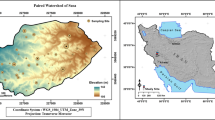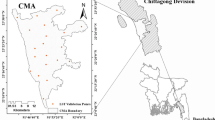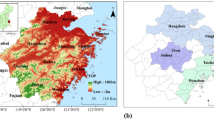Abstract
Land surface temperature (LST) is a fundamental variable in determining surface energy and water balances due to its control over the exchange of mass and energy between the soil surface and the atmosphere. This research aimed to investigate the relationship between spatial–temporal variability of LST and multiscale curvatures using the Extreme Gradient Boosting (XGBoost) algorithm in southwestern Iran. For this purpose, six curvatures were derived using the Wood method in three neighborhood scales (5 × 5, 15 × 15, and 25 × 25) from the 30-m Shuttle Radar Topography Mission digital elevation model. The Gaussian method was used for the landform classification. Emissivity was estimated based on the thresholding method of Normalized Difference Vegetation Index, and the average seasonal LST was calculated based on the Landsat 8 images taken during the 2013–2021 period using the inversion of Planck's function. The results depicted that neighborhood is a regulating factor in the amount of the detailed display of land surface features that in case of increasing its size, the rate of topographic surface bending decreases. In landform maps, four units that include the hill, closed depression, convex saddle, and concave saddle were identified, which have the lowest to the highest area within the studied region, respectively. The results of the Kruskal–Wallis test indicated that only the difference of each of the average LSTs of spring, summer, and winter between landform units classified based on 25 × 25 curvatures is significant (p-value < 0.05). The best performance of XGBoost models in explaining the variability in the average seasonal LST was obtained when the predictor variables were 25 × 25 curvatures (R2 values between 0.20 for spring LST and 0.11 for winter LST). XGBoost models predicted the values of average LST of the spring and summer more accurately than those of the autumn and winter. The difference between the R2 values of the XGBoost models based on the curvatures of 5 × 5 and 25 × 25 for the average LST of spring to winter is 0.14, 0.16, 0.15, and 0.11, respectively. The overall results of this research indicated the critical importance of neighborhood scale in capturing the variability of the environmental process studied in the landscape, while in many studies, the multiscale geomorphometric modeling has not been considered.
Similar content being viewed by others
Dataset and code availability
All datasets and codes used in this research are available on the https://khanifar.github.io/LSTMVs.html.
References
Albani M, Klinkenberg B, Andison DW, Kimmins JP (2004) The choice of window size in approximating topographic surfaces from digital elevation models. Int J Geogr Inf Sci 18(6):577–593
Bertoldi G, Notarnicola C, Leitinger G, Endrizzi S, Zebisch M, Della Chiesa S, Tappeiner U (2010) Topographical and ecohydrological controls on land surface temperature in an alpine catchment. Ecohydrol Ecosyst Land Water Process Interact Ecohydrogeomorphol 3(2):189–204
Carslaw DC, Ropkins K (2012) Openair—an R package for air quality data analysis. Environ Model Softw 27:52–61
Chen T, Guestrin C (2016) Xgboost: a scalable tree boosting system. In: Proceedings of the 22nd ACM SIGKDD international conference on knowledge discovery and data mining. ACM, New York, pp 785–794
Evans IS (1980) An integrated system of terrain analysis and slope mapping. Zeitschrift Für Geomorphologie Supplementband Stuttgart 36:274–295
Fekrat H, Asghari Saraskanrood S, Alavipanah SK (2020) Estimation of Ardabil land surface temperature using Landsat images and accuracy assessment of land surface temperature estimation methods with ground truth data. J RS GIS Nat Resources 11(4):114–136
Firozjaei MK, Makki M, Lentschke J, Kiavarz M, Alavipanah SK (2019) Spatioltemporal modeling the impact of surface characteristics variations on land surface temperature variations: a case study of Samalghan Vally. Int Arch Photogrammet Rem Sens Spat Inf Sci 42:401–405
Florinsky IV (1998) Accuracy of local topographic variables derived from digital elevation models. Int J Geogr Inf Sci 12(1):47–62
Florinsky I (2016) Digital terrain analysis in soil science and geology, 2nd edn. Academic Press, Amsterdam, pp 7–68
Florinsky IV (2018) Multiscale geomorphometric modeling of Mercury. Planet Space Sci 151:56–70
Franklin SE (2020) Interpretation and use of geomorphometry in remote sensing: a guide and review of integrated applications. Int J Rem. Sens 41(19):7700–7733
Gauss KF (1828) Disquisitiones generales circa superficies curvas. Comment Societ Regiae Scie Gottingen 6:99–146
Gorelick N, Hancher M, Dixon M, Ilyushchenko S, Thau D, Moore R (2017) Google earth engine: planetary-scale geospatial analysis for everyone. Remote Sens Environ 202:18–27
He L, Cheng Y, Li Y, Li F, Fan K, Li Y (2021) An improved method for soil moisture monitoring with ensemble learning methods over the Tibetan plateau. IEEE J Sel Top Appl Earth Observ Remote Sens 14:2833–2844
Huggett R, Cheesman J (2002) Topography and the environment. Prentice Hall
Khanifar J, Khademalrasoul A (2020) Importance of multi-scale geomorphometric algorithms in soil-landscape analysis. In: 7th National conference of iranian association of geomorphology (geomorphology, a new approach), Tehran, Iran (Persian Literature)
Khanifar J, Khademalrasoul A, Amerikhah H (2020) Modelling of soil aggregate stability as an index of soil erodibility using geomorphometric parameters. J Agric Eng Soil Sci Agric Mechanizat (sci J Agric) 43(1):45–60
Khanifar J, Khademalrasoul A (2021) Effects of neighborhood analysis window forms and derivative algorithms on the soil aggregate stability–Landscape modeling. CATENA 198:105071
Lam NS-N (2019) Resolution. In: Wilson JP (ed) The geographic information science & technology body of knowledge (2nd Quarter 2019 Edition). https://doi.org/10.22224/gistbok/2019.2.11.
MacMillan RA, Shary PA (2009) Landforms and landform elements in geomorphometry. In: Hengle T, Reuter HI (eds) Geomorphometry: concepts, software, applications. Elsevier, Amsterdam, pp 227–254
Minár J, Evans IS, Jenčo M (2020) A comprehensive system of definitions of land surface (topographic) curvatures, with implications for their application in geoscience modelling and prediction. Earth Sci Rev 211:103414
Mokarram M, Sathyamoorthy D (2018) A review of landform classification methods. Spat Inf Res 26(6):647–660
Mola Mehr Alizadeh F, Jannati M, Shayan S (2005) Efficiency of remote sensing (RS) data in landform mapping and its role in environmental planning. Hum Sci Modares 9(4):111–148
Olaya V (2009) Basic land-surface parameters. In: Hengle T, Reuter HI (eds) Geomorphometry: concepts, software, applications. Elsevier, Amsterdam, pp 141–170
Peng X, Wu W, Zheng Y, Sun J, Hu T, Wang P (2020) Correlation analysis of land surface temperature and topographic elements in Hangzhou. China Sci Rep 10(1):1–16
Raschka S (2018) MLxtend: Providing machine learning and data science utilities and extensions to Python’s scientific computing stack. J Open Source Softw 3(24):638
Rigol-Sanchez JP, Stuart N, Pulido-Bosch A (2015) ArcGeomorphometry: a toolbox for geomorphometric characterisation of DEMs in the ArcGIS environment. Comput Geosci 85:155–163
Roecker SM, Thompson JA (2010) Scale effects on terrain attribute calculation and their use as environmental covariates for digital soil mapping. In: Boettinger JL, Howell DW, Moore AC, Hartemink AE, Kienast-Brown S (eds) Digital soil mapping: bridging research, environmental application, and operation. Springer, Dordrecht, pp 55–66
Shamsoddini A, Madadi F (2019) Land Surface Temperature Mapping Based on Emissivity Fusion in Urban Areas. J Geomat Sci Technol (JGST) 9(2):77–91
Shary PA (1995) Land surface in gravity points classification by a complete system of curvatures. Math Geol 27(3):373–390
Soil and Land Suitability Evaluation report of justification studies of Watershed Management in the Remains of Dez Dam watershed (n.d.) Natural Resources organization of Iran (Persian Literature)
Taghizadeh-Mehrjardi R, Schmidt K, Toomanian N, Heung B, Behrens T, Mosavi A, Band SS, Amirian-Chakan A, Fathabadi A, Scholten T (2021) Improving the spatial prediction of soil salinity in arid regions using wavelet transformation and support vector regression models. Geoderma 383:114793
Wilson JP (2018) Environmental applications of digital terrain modeling. Wiley
Wood J (1996) The geomorphological characterisation of digital elevation models (Doctoral dissertation, University of Leicester)
XGBoost Parameters. 27 July 2021. https://xgboost.readthedocs.io/en/latest/parameter.html.
Zevenbergen LW, Thorne CR (1987) Quantitative analysis of land surface topography. Earth Surf Proc Land 12(1):47–56
Zhao W, Duan SB, Li A, Yin G (2019) A practical method for reducing terrain effect on land surface temperature using random forest regression. Remote Sens Environ 221:635–649
Zhang S, Zhang D, Qiao J, Wang X, Zhang Z (2020) Preventive control for power system transient security based on XGBoost and DCOPF with consideration of model interpretability. CSEE J Power Energy Syst 7(2):279–294
Zhong R, Johnson R Jr, Chen Z (2020) Generating pseudo density log from drilling and logging-while-drilling data using Extreme Gradient Boosting (XGBoost). Int J Coal Geol 220:103416
Zhu AX (2008) Keynote paper: spatial scale and neighborhood size in spatial data processing for modeling the natural environment. In: Mount N, Harvey G, Aplin P, Priestnall G (eds) Representing, modeling, and visualizing the natural environment. CRC Press, pp 147–165
Acknowledgements
This research is based on the datasets of Landsat 8, SRTM DEM, and meteorology. Remote sensing and machine learning analyses were performed in Google Earth Engine and Google Colaboratory. We thank all those who participated in the preparation and provision of these datasets and services.
Funding
This work was supported by Shahid Chamran University of Ahvaz [SCU.AS98.364].
Author information
Authors and Affiliations
Corresponding author
Ethics declarations
Conflict of interest
The author declares no known competing financial interests or personal relationships that could have appeared to influence the work reported in this paper.
Additional information
Editorial responsibility: Agnieszka Galuszka.
Rights and permissions
Springer Nature or its licensor holds exclusive rights to this article under a publishing agreement with the author(s) or other rightsholder(s); author self-archiving of the accepted manuscript version of this article is solely governed by the terms of such publishing agreement and applicable law.
About this article
Cite this article
Khanifar, J., Khademalrasoul, A. Modeling of land surface temperature–multiscale curvatures relationship using XGBoost algorithm (Case study: Southwestern Iran). Int. J. Environ. Sci. Technol. 19, 11763–11774 (2022). https://doi.org/10.1007/s13762-022-04409-z
Received:
Revised:
Accepted:
Published:
Issue Date:
DOI: https://doi.org/10.1007/s13762-022-04409-z











